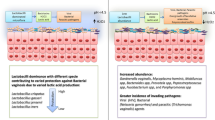Abstract
Introduction and hypothesis
Presence of microbial communities (microbiota) in an organ system depends on environmental factors, such as oxygen availability. We describe a novel technique to measure bladder urine oxygen tension (BUOT) in ambulatory women and use that technique to compare BUOT values to female urinary microbiota and participant urinary signs and symptoms.
Methods
Ambulatory female urogynecology patients presenting for clinical care who were willing to undergo transurethral catheterization underwent BUOT determination with a non-invasive flow-through oxygen sensor. To detect urinary microbiota in the bladder, 16S rRNA gene sequencing was performed on catheterized urine. Multivariate statistical analyses were performed to examine potential correlations among BUOT, urinary microbiota compositions and clinical variables.
Results
Significant variation in BUOT existed between individuals (range: 0.47–51.5 mmHg; median: 23.1 ± 13.5). Microbiota compositions were associated with BUOT (p = 0.03). BUOT was significantly lower in urines that were nitrite negative on dipstick analysis (p = 0.0001) and in participants who answered yes to having urinary leakage on the validated Urinary Distress Inventory (p = 0.01).
Conclusions
BUOTs can be measured in ambulatory women. For urogynecology patients, a wide range of values exist. BUOT may be associated with the presence of urinary microbiota and resultant signs and symptoms.



Similar content being viewed by others
References
Brezis M, Rosen S. Hypoxia of the renal medulla—its implications for disease. N Engl J Med. 1995;332(10):647–55.
Leonhardt KO, Landes RR. Oxygen tension of the urine and renal structures. Preliminary report of clinical findings. N Engl J Med. 1963;269:115–21.
Landes RR, Leonhardt KO, Duruman N. A clinical study of the oxygen tension of the urine and renal structures. ii. J Urol. 1964;92:171–8.
Andersson KE, Boedtkjer DB, Forman A. The link between vascular dysfunction, bladder ischemia, and aging bladder dysfunction. Ther Adv Urol. 2017;9(1):11–27.
Leonhardt KO, Landes RR. Urinary oxygen pressure in renal parenchymal and vascular disease. Effects of breathing oxygen. JAMA. 1965;194(4):345–50.
Pinggera GM, Mitterberger M, Steiner E, et al. Association of lower urinary tract symptoms and chronic ischaemia of the lower urinary tract in elderly women and men: assessment using colour doppler ultrasonography. BJU Int. 2008;102(4):470–4.
Wolfe AJ, Toh E, Shibata N, et al. Evidence of uncultivated bacteria in the adult female bladder. J Clin Microbiol. 2012;50(4):1376–83.
Karstens L, Asquith M, Davin S, et al. Does the urinary microbiome play a role in urgency urinary incontinence and its severity? Front Cell Infect Microbiol. 2016;6:78.
Brubaker L, Nager CW, Richter HE, et al. Urinary bacteria in adult women with urgency urinary incontinence. Int Urogynecol J. 2014;25(9):1179–84.
Hilt EE, McKinley K, Pearce MM, et al. Urine is not sterile: use of enhanced urine culture techniques to detect resident bacterial flora in the adult female bladder. J Clin Microbiol. 2014;52(3):871–6.
Khasriya R, Sathiananthamoorthy S, Ismail S, et al. Spectrum of bacterial colonization associated with urothelial cells from patients with chronic lower urinary tract symptoms. J Clin Microbiol. 2013;51(7):2054–62.
Price TK, Dune T, Hilt EE, et al. The clinical urine culture: enhanced techniques improve detection of clinically relevant microorganisms. J Clin Microbiol. 2016;54(5):1216–22.
Thomas-White KJ, Kliethermes S, Rickey L, et al. Evaluation of the urinary microbiota of women with uncomplicated stress urinary incontinence. Am J Obstet Gynecol. 2017;216(1):55.e1–55.e16.
Barber MD, Chen Z, Lukacz E, et al. Further validation of the short form versions of the pelvic floor distress inventory (PFDI) and pelvic floor impact questionnaire (PFIQ). Neurourol Urodyn. 2011;30(4):541–6.
Clayson D, Wild D, Doll H, Keating K, Gondek K. Validation of a patient-administered questionnaire to measure the severity and bothersomeness of lower urinary tract symptoms in uncomplicated urinary tract infection (UTI): the UTI symptom assessment questionnaire. BJU Int. 2005;96(3):350–9.
Pearce MM, Hilt EE, Rosenfeld AB, et al. The female urinary microbiome: a comparison of women with and without urgency urinary incontinence. MBio. 2014;5(4):e01283–14.
Schloss PD, Westcott SL, Ryabin T, et al. Introducing mothur: open-source, platform-independent, community-supported software for describing and comparing microbial communities. Appl Environ Microbiol. 2009;75(23):7537–41.
Freedman D, Pisani R, Purves R. Statistics. 4th ed. New York: W.W. Norton & Company; 2007.
Benjamini Y, Hochberg Y. Controlling the false discovery rate: a practical and powerful approach to multiple hypothesis testing. J R Stat Soc B. 1995;57:289–300.
Simerville JA, Maxted WC, Pahira JJ. Urinalysis: a comprehensive review. Am Fam Physician. 2005;71(6):1153–62.
Giannakopoulos X, Evangelou A, Kalfakakou V, Grammeniatis E, Papandropoulos I, Charalambopoulos K. Human bladder urine oxygen content: implications for urinary tract diseases. Int Urol Nephrol. 1997;29(4):393–401.
Ponholzer A, Temml C, Wehrberger C, Marszalek M, Madersbacher S. The association between vascular risk factors and lower urinary tract symptoms in both sexes. Eur Urol. 2006;50(3):581–6.
Author information
Authors and Affiliations
Corresponding authors
Ethics declarations
Conflicts of interest
MB Shannon: none. R Limeira: none. D Johansen: none. X. Gao: none. H Lin: none. Q Dong: none. AJ Wolfe: received research grants from Astellas and Kimberly-Clark. ER Mueller: received research grants from Astellas, is consultant for Butler-Snow/Ethicon and sits on a board for Boston Scientific.
Additional information
Publisher’s note
Springer Nature remains neutral with regard to jurisdictional claims in published maps and institutional affiliations.
Rights and permissions
About this article
Cite this article
Shannon, M.B., Limeira, R., Johansen, D. et al. Bladder urinary oxygen tension is correlated with urinary microbiota composition. Int Urogynecol J 30, 1261–1267 (2019). https://doi.org/10.1007/s00192-019-03931-y
Received:
Accepted:
Published:
Issue Date:
DOI: https://doi.org/10.1007/s00192-019-03931-y




